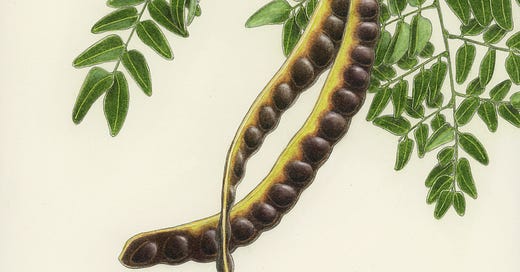Honey locust is a living example that a lot of life's choices are package deals. Here is a tree that has many virtues that make it popular for planting along America's city streets, yet it is armed with thorns of a size, sharpness and stiffness that would appear to make it a threat to public safety. This seems especially urgent, as the largest, multiply branched thorns, up to 8 or 10 inches long, occur in bunches on the trunk, seemingly ready to spear passers-by. A walk around the streets of Cambridge, Massachusetts passes by an occasional large honey locust tree whose mighty thorns seem ready to impale pedestrians waiting for the "Don't Walk" sign to change. The thorns are green when young, then turn ruddy brown when mature and grey as they become old and brittle. The fact that these thorns are modified branches doesn’t make them any less menacing.
What could be the reason for such fearsome defenses? Some scientists speculate that these thorns defended against giant herbivores that roamed the area during the Pleistocene Era, but have since become extinct. Thus, honey locust’s killer thorns may once have prevented mastodons from pushing over the tree to get at the nutritious pods too high to reach, much like elephants still push over trees today. The massive, stiff thorns assured that the mastodons would have to wait until the pods dropped to the ground, at which time, they could enjoy the sweet pulp that lines the pods, thereby eating the seeds and performing the tree’s “intended” purpose of getting the mastodon to disperse its seeds widely in its manure.
Honey locust is one of a several plant species with adaptations that seem without an apparent current function. These include plants with giant fruits, huge seeds, killer thorns, and other traits that may once have served or defended against animals that no longer exist. The giant ground sloths, mammoths, mastodons, gomphotheres, camels, and rhinoceros that selected for these traits over millions of years were gone 10,000 or more years ago, making these traits anachronisms, their usefulness out of sync with modern times, but with too little elapsed time to change or eliminate these expensive adaptations.


Honey locust has been introduced to many localities around the world, often deliberately. In Australia, it has become invasive in agricultural land, forming thickets that are truly impenetrable if you value your life, and whose thorns can puncture your tires if you drive over them. And of course, Australia, like North America, has no megafauna to keep these trees in check.
In planting killer honey locusts, the city of Cambridge also seems anachronistic, for thornless varieties that don’t menace public safety have been developed and planted widely for decades. Perhaps the city managers feared the return of mastodons? But currently, Pleistocene megafauna, including mastodons are pretty scarce on the streets of most American cities. Perhaps at the time, the mitigating qualities justified planting these untamed, dangerous trees --- easy transplantation, rapid growth, tolerance of lousy city environments, attractive compound leaves that turn beautiful yellow in autumn, and a long, attractive seed pod.
Or perhaps the city fathers wanted to offer Cambridge’s citizens a natural foods option, for the inner pulp of the unripe seed pod is sweet and edible, hence the tree's name. Unfortunately, it seems doubtful that any of Cambridge's dazzling urbanites and pointy-headed intellectuals would stop to collect the pods as a replacement for sushi, falafel and burgers. As for the giant thorns, I suppose they could be used for self-defense on the city's mean streets, but it would appear that cheap handguns are a lot more practical.





Another question! If there can be adaptations defending against ghosts, can there be likewise adaptations for hunting ghosts? Giant tusks or claws for bringing downlarge or thick-skinned prey now extinct?
Can the trunk thorns be removed with a lopper when they appear? Perhaps that would eliminate the dangers from the lower reaches of the tree? I wonder if any of the extinct megafauna tried that out. Any tests of beaver/young honey locust tree interactions?